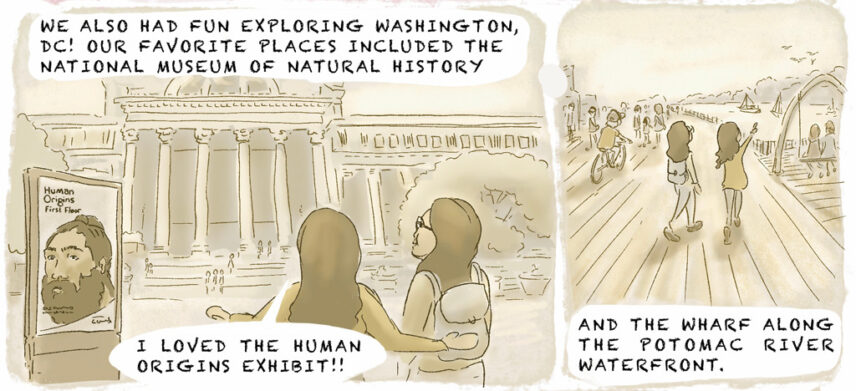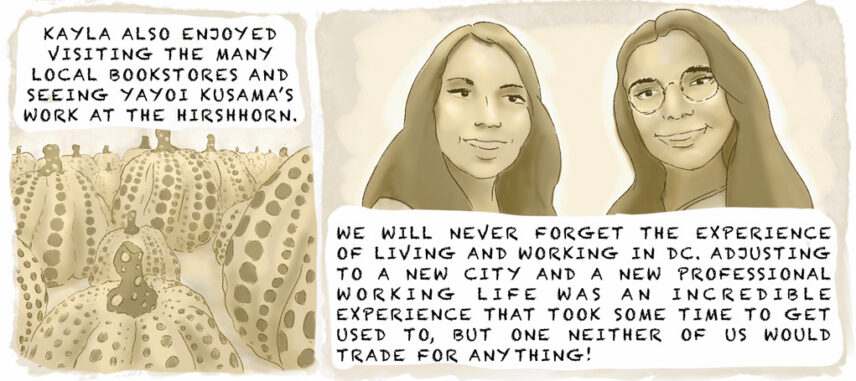Article begins
The Louise Lamphere Internship Program provides students with an opportunity to engage with anthropology outside the classroom. The unique structure of the program allows interns to split their time between AAA offices and our program partners at the Smithsonian Center for Folklife and Cultural Heritage and the Naval History and Heritage Command (NHHC). Throughout the six-week program, interns gain valuable work and research experience, develop professional skills, and explore different career paths.
Illustrator bio: Charlotte Corden is an illustrator and fine artist whose work often centers around what it is to be human. She has an MA in anthropology from University College London and has studied at the London Fine Art Studios and the Arts Students League of New York.
Two brunette women sit across from each other at a table. They both smile and are holding cups. One of the women wears classes; the name above her head is Kayla. The other woman has longer, wavier hair; the name above her head is Jeannette. Through the window behind them, foliage and the capitol building can be seen. Kayla says, “Twice a week, we worked for the AAA, typing away and meeting with various departments.” Jeannette adds, “We had different tasks, although we worked together on some of them, like this article!”
Jeannette sits in front of a desk, hands on a keyboard, and stretching out behind her are pages of paper with writing on them, looking as if they’re lining a tunnel. Pie charts, a color-coded map, and other graphs fill the square next to her. Narration above her head reads “Jeannette used quantitative methods to create and cross-reference data visualizations based on the 2021 member survey.” Jeannette says, “It was rewarding to see the numbers and information come together in the graphics.”
Kayla sits in front of a computer screen with different pages of text and data emanating from the screen. In the drawing next to that, she is standing in front of museum panels hanging on the wall, adjusting one. The narration reads, “Kayla updated educational content for the World on the Move public education exhibit and website by identifying relevant educational standards and multimedia resources.” Then, Kayla says, “I learned about the whole process of exhibit curation and how it relates to education. It’s something I want to continue exploring.”
A long panel shows Jeannette sitting and writing with a pen. Artifacts form an arc across the frame leading to a ship with sails on the waves. Narration across the top reads “With the NHHC’s underwater archaeology branch, Jeannette focused on artifact documentation of the Royal Savage, an American Revolutionary ship that was recovered in the 1930s. Jeannette says, “I had never dealt with artifacts from a sunken ship before. They were very exciting to see and get ahold of!”
The head of an axe dominates one side of the panel: it bears a label on it and a scale below it, as well as narration reading “an axe head with a hand-written sticker on it.” Beside that, Jeannette stands with a laptop in hand and the axe head rests on a table here. Bright lights shine one the table, screens flank the table, and an overhead camera flashes, taking an image of the artifact. The narration reads “The documentation process included photographing the artifacts to aid record keeping and pre-treatment showing of the object.” Jeannette says, “These were useful skills to hone, especially for future endeavors.”
Jeannette is in the foreground of an ongoing scene where four people wearing white coats and goggles examine and move a very large cannon that has chains suspending it while it also rests on blocks. The narration reads, “There was always something interesting going on in the lab. On ‘Cannon Day’ we moved a cannon to clean and examine it. It weighed over 1,000 pounds!” Jeannette says, “It was really cool to see the restoration process!”
Kayla holds a clipboard and looks intently at two people she is in conversation with. In the background, there are crowds milling around. A large sign in the background is emblazoned with the words “earth optimism x FOLKLIFE.” The narration reads “At the CFCH, Kayla evaluated the impact of the Smithsonian Folklife Festival, which involved interviewing participants of the Earth Optimism x Folklife program to learn about their experiences.”
This panel is split into two boxes. In the first, Kayla is speaking with two people, hands outspread and holding a clipboard. The two people appear to be the same two people from the previous frame. In the second box, Kayla is sitting at a desk and typing on a keyboard. Graphs and lines are on the screen and beside her are a cup and mouse. A thought bubble mulls, “While at first daunting, it was exciting to interview festival participants and enjoy some engaging conversations about sustainability, especially in relation to my environmental studies major.” In the second box, Kayla says, “Afterward, I conducted content analysis and analyzed a visitor survey to bring all the data together.”
Kayla stands at a large table, inspecting and hand touching the object dominating most of the table space. It appears to be a loom with fabric stretching across the table and in the middle there are numerous pieces of paper overlapping and woven into the threads. Next to that is a laptop. The narration reads, “One highlight was counting the visitor action pledges woven into a loom created by the organization around the world in 80 fabrics.”
This frame includes two panels. Kayla and Jeannette stand in front of an expansive building, looking up at it, and there’s a large display sign that reads “Human Origins First Floor” with the face of a bearded person. Both women walk across a crowded wooden boardwalk along the riverfront. The narration reads, “We also had fun exploring Washington, DC! Our favorite places included the National Museum of Natural History and the wharf along the Potomac River waterfront.” Below that, Jeannette in the first panel exclaims, “I loved the human origins exhibit!!”
This frame includes two panels. Pumpkins fill the first box, all decorated with circles in lines up their sides. The other panel features Kayla and Jeannette looking out at the viewer, smiling. The narration reads, “Kayla also enjoyed visiting the many local bookstores and seeing Yayoi Kusama’s work at the Hirschhorn. We will never forget the experience of living and working in DC. Adjusting to a new city and a new professional working life was an incredible experience that took some time to get used to, but one neither of us would trade for anything!”












